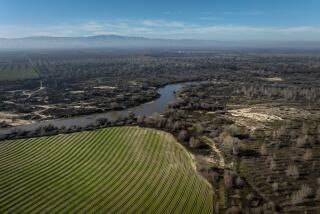Old Sacramento gives up some watery secrets during tour
Reporting from Sacramento—Old Sacramento creates a convincing picture of life in the Old West. Historic storefronts line lumpy brick streets, store clerks wear 19th century costumes and steamboats still ply the nearby Sacramento River, once the city’s economic lifeline.
But dig deeper — about 9 feet or so — and a secret city emerges.
“If California is a state of water, then Sacramento has the best water tale of all,” Staci Cox says.
Cox oversees Underground Tours organized by the Sacramento History Museum, which began last year and have become a popular draw in the state historic park. Guides, some in period costumes, lead visitors underneath the city to tell the tale of how flood-weary Sacramento pulled off an engineering feat that changed the course of its history.
Miss Odette, a.k.a. docent Jane Hastings, has led me to the dirt-floor bottom of a building on a recent weekend tour to describe what happened.
“They raised a 2½-mile section of the city about 9 feet,” she explains from her underground perch. “It took 15 years to finish. It’s a rare city that accomplishes that.”
All of this happened after the Gold Rush of 1849. Sacramento had transformed itself into an agricultural and transportation hub and was trying to smooth its rough edges.
Its location at the meeting of the Sacramento and American rivers was a boon and a curse: good for transportation and commerce, not so good for staying dry. Levees were built in the 1850s, but the flood in the winter of 1861-62 was a game changer.
The series of storms that battered Sacramento and all of California started on Christmas Eve in 1861 and lasted 45 days. The city’s rivers overflowed and swept thousands to their death. A giant inland “lake” — more than 250 miles long and 20 to 60 miles wide — submerged the streets of what is now Old Sacramento for three months. The city quickly had to figure out a way to make itself flood-proof to sustain its economic might.
Enter the street-raising plan.
“The interesting thing about it is the citizens themselves went to the political leaders … because they didn’t want to fall victim to floods again,” city historian Marcia Eymann says. “They agreed to self-tax to make the process work.” Yes, businessmen agreed to tax themselves to fund the civic project.
Sacramento’s biggest fear was that economic rival San Francisco would steal the state capital, a fear that wasn’t entirely unfounded. During the big flood, the Legislature temporarily decamped to San Francisco to escape disease-laden floodwaters. To make matters worse, newly elected Gov. Leland Stanford was forced to take a rowboat to his own inauguration in 1862.
Miss Odette unspools this history as she walks along a wooden pathway in the dank and dim basement of the one-time B.F. Hastings building at 2nd and J streets. Here brick walls seal off what would have been the city’s original sidewalks where miners and speculators would have walked during the Gold Rush era. She refers to the subterranean gap as a “hollow sidewalk,” noting the city’s “new” streets as much as 9½ feet above.
Next, she describes how the city shored up its image and its streets. The 19th century technology of choice: the puny house jack — and lots of manpower.
Buildings were cut off their foundation and placed on a lattice of logs to be hoisted into place with the jacks. The city filled in the gap between the two street levels with mud and sand. Some business owners chose to abandon the ground floor of their establishment rather than spend money to raise the building.
Either way, the city persevered — sometimes conducting business up top, sometimes below — until an area roughly between I and N streets and bordered by the Sacramento River had been raised above the high water level.
Along with the bricked-off walkways and empty basements, the tour displays remnants of 19th century life — whiskey bottles in odd shapes, bits of a porcelain chamber pot, a doll’s head, a wooden chair — that put a human face on the tale of survival.
Other stories are woven into this water tale too. There were women, especially women of color, who ran thriving businesses here. Some were wiped out by the flood, others by the cost of the raising their stores. And then there were the “horizontal businesswoman” that Miss Odette whispers about.
But the larger story is really that of a scrappy frontier town that faced down Mother Nature. “Placing a city at the confluence of two rivers isn’t practical in the first place,” historian Eymann says. “It’s practical in the sense of enterprise but not in the sense of the environment.”
This cycle of man-versus-wild would define frontier towns and cities throughout the West; some would thrive, others became ghost towns.
The story of Sacramento’s greatest flood and the resultant secret city is more than just an interesting chapter in history. What was labeled a 200-year flood could happen again.
But, says Heather Downey, who wrote the historical interpretation for the tours, “It’s an indomitable city. The Underground Tour is the story of Sacramento. That’s our spirit. That’s what it means to be a Sacramentan.”
More to Read
Sign up for The Wild
We’ll help you find the best places to hike, bike and run, as well as the perfect silent spots for meditation and yoga.
You may occasionally receive promotional content from the Los Angeles Times.







